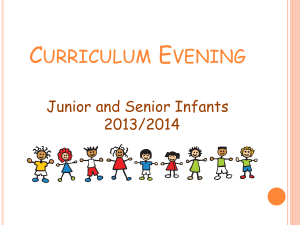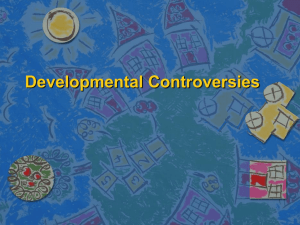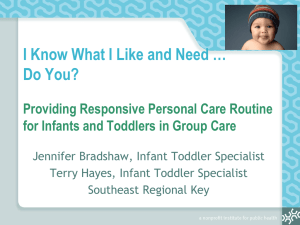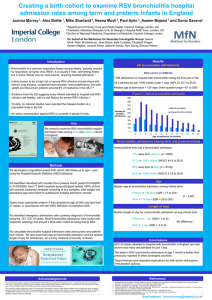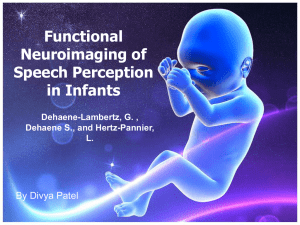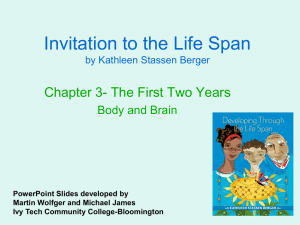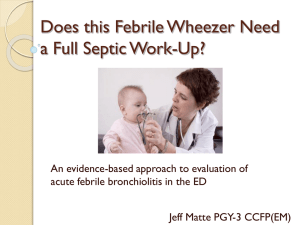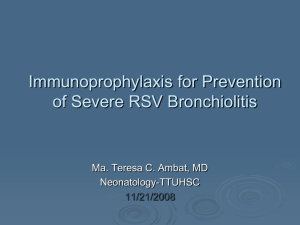Pediatric Hospital Medicine Top 10 Articles
advertisement
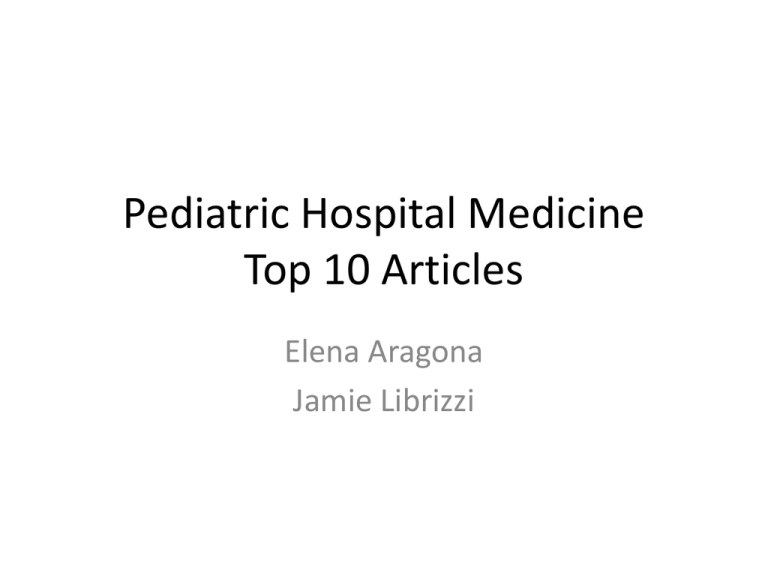
Pediatric Hospital Medicine Top 10 Articles Elena Aragona Jamie Librizzi Objectives • Summarize important evidence-based literature relating to pediatric hospital medicine • Appraise key PHM articles as they relate to clinical practice Apparent Life-Threatening Events • Patient 1: 5 month old female p/w ALTE – – – – Difficulty catching breath Face turned red Lasted ~10 seconds 15min after feed • Patient 2: Ex 34 wk 2mo M p/w ALTE – Hx ALTE 2 wks ago – Went limp for ~30 seconds – Not associated with feed P: In infants presenting with ALTE I/C: are there any factors O: that increase risk of subsequent event? Management of Apparent Life-Threatening Events in Infants: A Systematic Review • Objective: lit review to determine – Hx and PE features that suggest inc risk of future adverse event and/or serious dx – What testing is indicated • Methods: – Pertinent articles identified and critically appraised • 1970-2011 • ALTE in children <24mo • Results: – 37 studies identified • 14 investigated history/PE features • 31 evaluated diagnostic testing • All studies observational; none well suited to define w/u or determine prognosis… Management of Apparent Life-Threatening Events in Infants: A Systematic Review • Results: – Features associated with future adverse event and/or serious underlying diagnosis • Prematurity • Multiple ALTE • Suspected child abuse – Little evidence to support routine testing of all patients without these risk factors Meningitis • ED calls re: 6yo M with fever & headache found to have CSF pleocytosis, would like to admit on IV abx for bacterial meningitis r/o P: In children presenting pleocytosis I/C: Is there a clinical score to identify children with high risk for O: Bacterial Meningitis JAMA Clinical Prediction Rule for Identifying Children with CSF Pleocytosis at Very Low Risk of Bacterial Meningitis • Objective: – To validate clinical prediction rule (Bacterial Meningitis Score) • Methods: – Review records of children with meningitis evaluated in ED of 20 academic medical centers over 4 years • Inclusion: 29d – 19yo with ICD9 diagnosis of meningitis • Exclusion: – Critical illness, purpura, VP shunt, recent neurosurgery, immunosuppression, other bacterial infection requiring inpt abx, active lyme disease, pts with abx within 72h of LP • Bacterial meningitis: + CSF culture OR CSF pleocytosis with + BCx OR CSF pleocytosis with + CSF latex agllutination test for bacteria – N = 2903 (met inclusion criteria, data available) Clinical Prediction Rule for Identifying Children with CSF Pleocytosis at Very Low Risk of Bacterial Meningitis • Results: – 1714 low risk patients • 2 had bacterial meningitis (infants 1-2mo w E Coli meningitis and UTI; neg UA at presentation) – NPV: 99.9%, (95% CI 99.6%-100%) – 1189 not low risk • 119 (10%) had bacterial meningitis • >/= 1 risk factor – Sensitivity 98.3% (95% CI 94.2%-99.8%) – Specificity 61.5% (95% CI 59.7%-63.3% – Use caution when applying to infants <2mo • In patients >2mo, >/=1 risk factor had sensitivity 100% • Pts <2mo, >/=1 risk factor had sensitivity 92.3% Blood Cultures • 20mo M with L thigh cellulitis – Failed outpt therapy; plan to admit on clindamycin • Blood culture? P: In patients with asthma, bronchiolitis, pneumonia, SSTI I: does obtaining blood culture C: versus no blood culture O: affect outcomes? Do We Need This Blood Culture? Kavita Parikh, Aisha Barber Davis, Padmaja Pavuluri Hospital Pediatrics 2014; 4; 78 DOI: 10.1542/hpeds.2013-0053 Do We Need This Blood Culture? • Objective: – To assess BCx rates & results for 4 leading pediatric diagnoses in low-risk patients • Methods: – Retrospective cohort – Review records over 1 y at CNMC • Inclusion: 6mo – 18yo with bronchiolitis, asthma, SSTI, CAP • Exclusion: complex pts • N = 5159 (1629 inpt, 3530 outpt/ED) Do We Need This Blood Culture? • Results: • BCx – BCx in 343 pts: • 21% of inpts, 3% of ED/outpts – – – – 4% in asthma 15% in bronchiolitis 36% in pna 46% in SSTI – BCx results • Asthma – all neg • Bronchiolitis – all neg • SSTI – 98% neg or contaminant – 2 MRSA, 1 GAS • CAP – 99% neg or contaminant – 1 strep pneumo, 1 moraxella – Longer LOS in asthma, bronchiolitis – If + (n=5), no change in management • Some got rpt BCx though • ~$100,000 microbiology costs at our institution SBI Rule Out in Infant • 3 wk M with fever – Well appearing, labs reassuring – Admitted on IV antibiotics P: Neonates <1 mo admitted w/fever for IV antibiotics I: Discharge at 36h C: Discharge at 48 hour O: No missed/untreated SBI Time to Detection of Bacterial Cultures in Infants Aged 0-90 days Rianna C. Evans and Brian Fine Hospital Pediatrics 2013;3;97 DOI: 10.152/hpeds.2012-0025 Time to Detection of Bacterial Cultures in Infants Aged 0-90 days • Objective: determine if bacterial cultures in infants <90d would grow pathogenic bacteria in <36h • Methods – Retrospective Chart Review over 3.5y @ single institution – Infants 0 to 90 d evaluated in ED or inpt for SBI – Excluded: indwelling catheters, ‘sick’, rpt cx • Data Collection – Manual chart review of all blood, urine, CSF cultures • True + vs. contaminant - Determined based on tx Time to Detection of Bacterial Cultures in Infants Aged 0-90 days • CNMC: – BCx: checked q10min, alarm if + gram stain, team called • First subsequent read at 16-18 hours, then q24h – CSF cultures • Goal gram stain within 1 hour • First time to check culture: 16-18 hours, then q24h – Urine cultures • First read at 16-18 hours, then daily – Can call at night and ask someone to check if still neg Time to Detection of Bacterial Cultures in Infants Aged 0-90 days • Results – 2092 blood cultures; 101/115 + blood cultures included in analysis • 97% true pathogen (n=38) Bcx grew in 36h – 2283 urine cultures; 192/232 + urine cultures included in analysis • 95% true pathogen (n=111) Ucx grew in 36h – 1159 csf cultures; all 14+ included in analysis • 86% true pathogen (n=7) CSFcx grew in 36h UTI Length of Treatment in Infant • 3mo F with fever found to have UTI – Admitted on Ceftriaxone P: Infants admitted with UTI I: Transition to oral antibiotics after 3d C: versus longer IV therapy O: Treatment failure Length of Intravenous Antibiotic Therapy and Treatment Failure in Infants with Urinary Tract Infections Patrick W. Brady, Patrick J. Conway and Anthony Goudie Pediatrics 2010; 126; 196 DOI: 10.1542/peds.2009-2948 Length of IV Abx Therapy in Infants with UTI • Objective: – To assess short (<=3d) v long (>=4d) IV abx therapy and treatment failure in infants <6mo admitted with UTI • Treatment failure = readmit within 30d • Methods: – Retrospective cohort, infants <6mo admitted to 24 children's hospitals over 5y with UTI or pyelo (PHIS) • Excluded kids w complex conditions Length of IV Abx Therapy in Infants with UTI • Results: 12,333 kids met inclusion criteria – Male gender, neonatal status, black, Hispanic, nonprivate insurance, known bacteremia, GU abnormality – inc likelihood of receiving IV abx Length of IV Abx Therapy in Infants with UTI • Results – Treatment failure overall: 1.9% • 1.6% in short-course, 2.2% in long-course – Ie maybe sicker pts got long iv abxs and more likely to fail • Outcome by pt characteristic and length of IV abx » ie gender, age by 1month intervals, race, bacteremia, GU abnormality) – Only GU abnormality and severity of illness associated w treatment failure – Multivariate adjustment (addressed confounders ie severity of illness) – no association between treatment group and outcome Osteomyelitis • 10y male admitted for fever, L foot pain – MRI confirmed evidence of osteomyelitis – Patient started on Clinda IV P: In patients with osteomyelitis does I: Early transition to PO Abx C: Versus prolonged IV therapy O: Affect clinical outcomes? Prolonged Intravenous Therapy Versus Early Transition to Oral Antimicrobial Therapy for Acute Osteomyelitis in Children Theoklis Zaoutis, et al. Pediatrics 2009; 123;636 DOI: 10.15442/peds.2008-0596 Prolonged Intravenous Therapy Versus Early Transition to Oral Antimicrobial Therapy for Acute Osteomyelitis in Children Theoklis Zaoutis, et al. Pediatrics 2009; 123;636 DOI: 10.15442/peds.2008-0596 Prolonged IV Therapy Versus Early Transition to PO for Osteomyelitis • Objective: Compare the effectiveness of early transition from IV to PO for acute, uncomplicated osteo • Methods: Retrospective cohort study (PHIS) – Children aged 2m-17y dx with osteo between 20002005 at 29 free-standing children’s hospitals • Results: – 1o outcome: Tx failure (readmission w/in 6m) – 2o outcome: Readmit w/in 6m for line complication, adverse drug rxn, C. Diff, agranulocytosis Prolonged IV Therapy Versus Early Transition to PO for Osteomyelitis Results: 1021 prolonged IV, 948 PO • Overall readmission rate significantly higher in prolonged IV group (10% vs 6%, p= 0.017) • 1o outcome – 5% for prolonged IV group; 4% PO group – No significant association btw Tx failure and mode Abx therapy • 2o outcome – Prolonged IV therapy group more likely to experience Tx-related complication • 3% readmitted for catheter complications, 1.6% for Abx complications (vs 0.4% in PO group, p= 0.005) GERD • 2m FT male admitted for persistent emesis with feeds associated with back arching, fussiness – Pt growing appropriately – Work-up only reveals reflux GERD • 2m FT male admitted for persistent emesis with feeds associated with back arching, fussiness – Pt growing appropriately – Work-up only reveals reflux Are there risks associated with empiric acid suppression treatment of infants and children suspected of having GERD Erica Y. Chung and Jeremy Yardley Hospital Pediatrics 2013;3;16 DOI: 10.1542/hpeds.2012-0077 Are there risks associated with acid suppression therapy? • Objective: Evaluate the potential serious adverse effects associated with acid suppressive meds in the pediatric population • Methods: PubMed search – Ages 0-18y; placebo-controlled or comparisons with a nonacid suppression arm • Results: 14 studies included – NICU, PICU, non-critical care Are there risks associated with acid suppression therapy? Results • NICU – Increased risk NEC, sepsis/bacteremia • PICU – Mixed results on VAP • Non-critical care – Increased rate PNA, LRTI, gastroenteritis – Associated with C. Diff associated disease Bronchiolitis • 6wk female admitted with URI symptoms, increased WOB and fever found to be RSV+ – Should she be evaluated for SBI? P: In infants with bronchiolitis I: Is testing for serious bacterial infection C: Compared to not testing O: Indicated? Risk of serious bacterial infection in young febrile infants with RSV infections Levine D, et al. Pediatrics 2004; 113;1728-1734 DOI: 10.1542/peds.113.6.1662 Serious Bacterial Infections in Infants with RSV • Methods: Multi-center prospective, cross-sectional study (1998-2001) – All febrile infants, aged 0-60d undergoing SBI eval – RSV testing by antigen detection from NP swabs • Results – 1248 enrolled (22% tested + RSV) – Overall SBI rate 11.4% (0.7% meningitis, 2% bacteremia, 9.1% UTI) – RSV+ infants less likely to have SBI (7% vs 12.5%; RR 0.6) Table 3. SBI by RSV Status Serious Bacterial Infections in Infants with RSV Results: Age-stratified • <28d: Overall rate of SBI did not differ significantly btw those who were RSV+ and RSV- (10.1% vs 14.2%, RR 0.71, 95% CI 0.351.5) • 29-60d: Overall rate of SBI was 5.5% (no bacteremia or meningitis) with statistically significant difference between RSV+ and RSV(5.5% vs 11.7%, RR 0.47, 85% CI 0.24-0.91) HSV • 20d male presenting with fever and irritability – No maternal history of HSV – Full SBI evaluation initiated – Should HSV and empiric Acyclovir be done? P: In infants presenting for evaluation I/C: What history/PE/labs are associated O: With HSV infection HSV • Methods: Retrospective case study of HSV over 22y (1988-2009) period from single institution – Inclusion: infants <60d with final dx HSV • Results: – 32 cases included (25 confirmed, 7 probable); all empirically tx w/ Acyclovir – 75% of cases with CNS disease HSV • Results: – 1.3% empirically treated infants ultimately diagnosed with HSV – 90% cases in infants <21d – 50% presented w/ non-specific complaints – 53% presented with fever, 13% hypothermia – HSV meningitis: 1/3 had <20 WBC in CSF – Except in disseminated disease, routinely obtained labs were not distinctive in HSV-infected infants Pneumonia • 4yo M admitted with cough, fever, hypoxia and CXR with RML infiltrate – What is the evidence to support the 2011 IDSA guideline to use Ampicillin as first-line therapy for CAP? P: In children hospitalized with communityacquired PNA I: Does treatment with narrow-spectrum Abx (i.e: Ampicillin) C: Compared to broad spectrum (i.e: 3rd generation cephalosporin) O: Have better clinical outcomes? Narrow vs broad spectrum antimicrobial therapy for children hospitalized with PNA Williams DJ, et al.* Pediatrics 2013; 132;e1141-8 * Kavita Parikh, CNMC DOI: 10.1542/peds.2013-1614 Narrow vs Broad Spectrum Abx Tx for PNA • Methods: Retrospective cohort study; 42 children’s hospitals btw 2005-2011 (PHIS) – Included children aged 6m-18y hospitalized >2d – Excluded potentially severe PNA, pts at risk for healthcare assoc infections, pleural drainage/PICU/mech vent within first 2 days • Results: – 1o outcome: LOS – 2o outcome: PICU, 14d readmission, costs Narrow vs Broad Spectrum Abx Tx for PNA • Results: 15,564 children included – 89.7% broad-spectrum, 10.3% narrow-spectrum • No significant difference in LOS btw groups (when adjusted for confounders) • No significant difference in PICU admits, 14d readmissions • No significant difference in sub-analysis of wheezers • No significant difference on costs (adjusted analysis) Runners Up… • Biondi et al. Treatment of Mycoplasma Pneumonia: A Systematic Review. Pediatrics, 2014; 113; 1081. • Starmer et al. Rates of Medical Errors and Preventable Adverse Events Among Hospitalized Children Following Implementation of a Resident Handoff Bundle (IPASS). JAMA, 2013; 310(21): 2262-2270. • Mussman et al. Suctioning and Length of Stay in Infants Hospitalized with Bronchiolitis. JAMA Pediatrics, 2013; 167(5): 414-421. • Fernandes et al. Glucocorticoids for Acute Viral Bronchiolitis in Infants and Young Children. Cochrane Database Syst Rev. 2013; 6: CD004878. • Salo et al. Childhood Urinary Tract Infections as a Cause of Chronic Kidney Disease. Pediatrics. 2011; 128(5): 840-847. • Ralston et al. Occult Serious Bacterial Infection in Infants Younger than 60 to 90 Days with Bronchiolitis: a Systemic Review. Arch Pediatr Adolesc Med. 2011; 156(10):951-956. Next Session: March 2015 • Review Guidelines: – 2006 AAP Bronchiolitis Guidelines – 2011 IDSA PNA Guidelines – 2011 IDSA UTI Guidelines – 2004 AAP Kawasaki Endorsed Clinical Report – 2011 IDSA MRSA Guidelines

